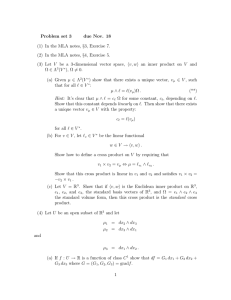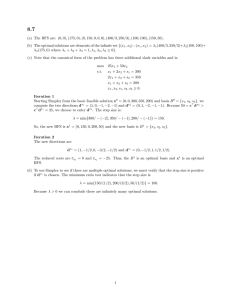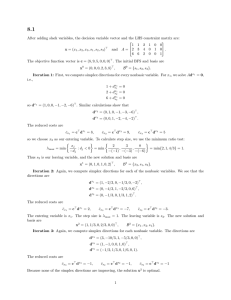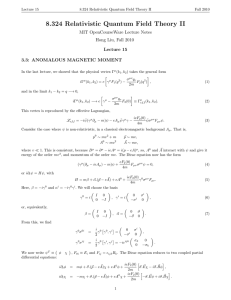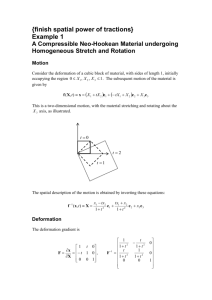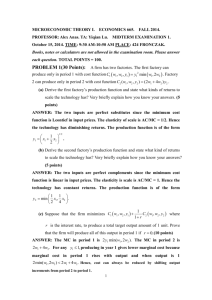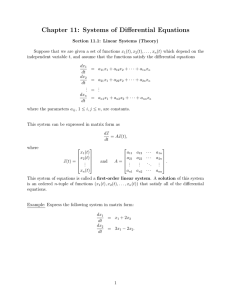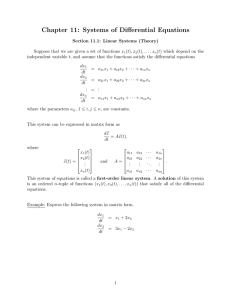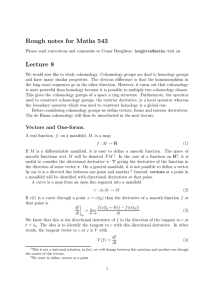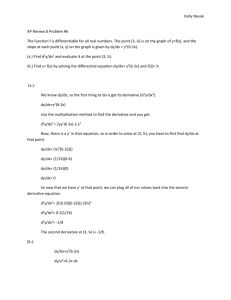PHZ3113–Introduction to Theoretical Physics Fall 2008 Problem Set 8 Solutions Oct. 6, 2008
advertisement
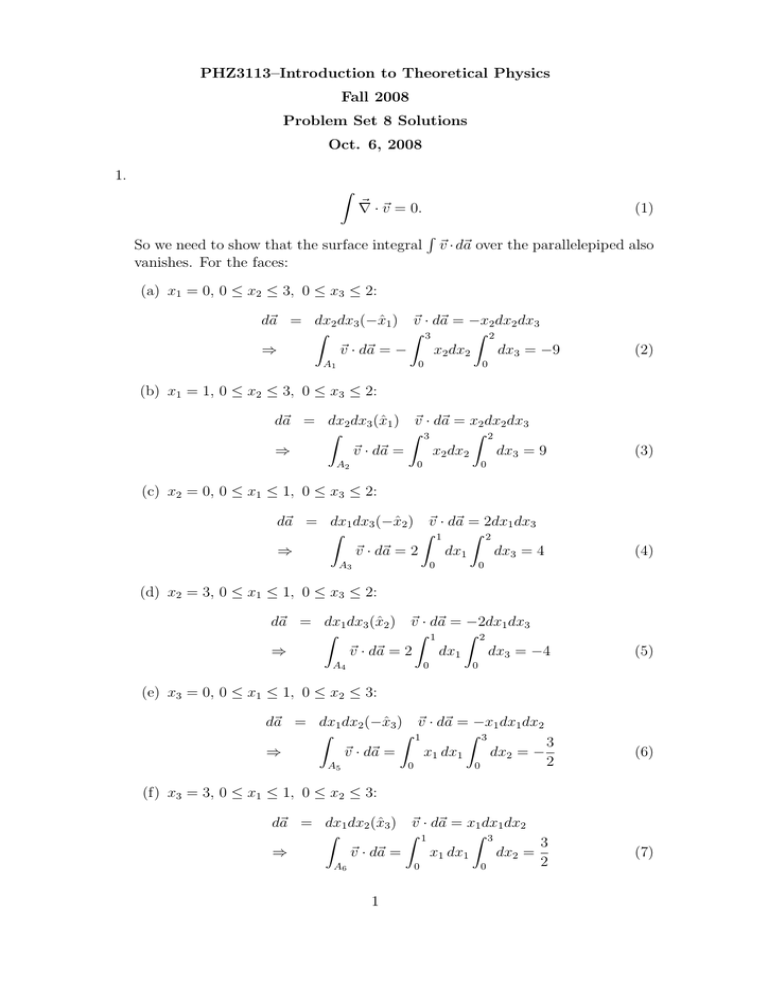
PHZ3113–Introduction to Theoretical Physics Fall 2008 Problem Set 8 Solutions Oct. 6, 2008 1. Z ~ · ~v = 0. ∇ (1) R So we need to show that the surface integral vanishes. For the faces: ~v · d~a over the parallelepiped also (a) x1 = 0, 0 ≤ x2 ≤ 3, 0 ≤ x3 ≤ 2: d~a = dx2 dx3 (−x̂1 ) ~v · d~a = −x2 dx2 dx3 Z Z 3 Z 2 ⇒ ~v · d~a = − x2 dx2 dx3 = −9 A1 0 (2) 0 (b) x1 = 1, 0 ≤ x2 ≤ 3, 0 ≤ x3 ≤ 2: d~a = dx2 dx3 (x̂1 ) ~v · d~a = x2 dx2 dx3 Z Z 3 Z 2 ⇒ ~v · d~a = x2 dx2 dx3 = 9 A2 0 (3) 0 (c) x2 = 0, 0 ≤ x1 ≤ 1, 0 ≤ x3 ≤ 2: d~a = dx1 dx3 (−x̂2 ) ~v · d~a = 2dx1 dx3 Z Z 1 Z 2 ⇒ ~v · d~a = 2 dx1 dx3 = 4 A3 0 (4) 0 (d) x2 = 3, 0 ≤ x1 ≤ 1, 0 ≤ x3 ≤ 2: d~a = dx1 dx3 (x̂2 ) ~v · d~a = −2dx1 dx3 Z Z 1 Z 2 ⇒ ~v · d~a = 2 dx1 dx3 = −4 A4 0 (5) 0 (e) x3 = 0, 0 ≤ x1 ≤ 1, 0 ≤ x2 ≤ 3: d~a = dx1 dx2 (−x̂3 ) ~v · d~a = −x1 dx1 dx2 Z Z 1 Z 3 3 ⇒ ~v · d~a = x1 dx1 dx2 = − 2 A5 0 0 (6) (f) x3 = 3, 0 ≤ x1 ≤ 1, 0 ≤ x2 ≤ 3: d~a = dx1 dx2 (x̂3 ) ~v · d~a = x1 dx1 dx2 Z Z 1 Z 3 3 ⇒ ~v · d~a = x1 dx1 dx2 = 2 A6 0 0 1 (7) ... so the surface integral over the faces cancel pairwise. 2. (a) Basic proof is as follows: ~ × ~r) = 1 B( ~ · ∇)~ ~ r ~ ×A ~ = ∇ ~ × 1 (B ~ ∇ ~ · ~r) − 1 (B ∇ 2 2 2 3~ 1~ ~ = B− B=B 2 2 (8) ~ In the 2nd step we could not have pulled B ~ to the left for any constant B. of the differential operator unless it were constant, ~ × (B ~ × ~r)i = ²ijk ∇j (B ~ × ~r)k = ²ijk ∇j ²k`m B` xm (∇ = (δi` δjm − δim δj` )∇j B` xm = (δi` δjm − δim δj` )[(∇j B` )xm + B` (∇j xm )]. (9) ~ does the first term in the square brackets vanish, Only for constant B giving you (8). (b) ~ ·B ~ =∇ ~ · (∇u ~ × ∇v) ~ = ∇v ~ · (∇ ~ × ∇u) ~ − ∇u ~ · (∇ ~ × ∇v) ~ = 0, ∇ (10) where the first equality follows from the gradient version of the “BACCAB” identity (see vector identity sheet) and the second identity from ~ × ∇φ ~ = 0. ∇ (c) ~ ×A ~ = 1∇ ~ × (u∇v ~ − v ∇u) ~ ∇ 2 1 ~ ~ + (∇u ~ × ∇v) ~ − v∇ ~ × ∇u ~ − (∇v ~ × ∇u)] ~ = [u∇ × ∇v 2 1 ~ × ∇v) ~ − 0 − (∇v ~ × ∇u]) ~ ~ × ∇v) ~ =B ~ = [0 + (∇u = (∇u 2 ~0 = ∇ ~ × (A ~ + ∇ψ) ~ ~ +∇ ~ × ∇ψ ~ = 0. So =B (d) Transformed magnetic field B the left hand side of Stokes’ law is invariant. The extra term on the right hand side generated by the transformation is I ~ · d~r = 0, ∇ψ (11) since the integral is taken around a closed loop and the vector field being integrated around the loop is the gradient of a scalar (conservative). 3. Expand function g(x) in the neigbhorhood of each point where its argument becomes zero; only at these points will the δ-function be significant: Z X Z an +² f (x)δ(g(x))dx = f (x)δ[g(an ) + (x − an )g 0 (an )]dx, (12) n an −² 2 where ² is a small quantity. Note also that g(an ) = 0 by definition. Since we 1 know that δ(ax) = |a| δ(x), we may write = XZ dxf (x) n 1 δ(x − an ) |g 0 (an )| (13) as desired. Note this is not an approximation, since the δ function is exactly zero away from the zeros of its argument. 4. Before proceeding, note that the argument of the δ function has 2 roots, but only one of them is within the range of integration, x = 1/2. So Z ∞ Z δ(x − 1/2) 2 2 (3x + 5)δ(2x + 3x − 2) = (3x2 + 5) |4 · 12 + 3| 0 Z 1 1 23 23 = (3x2 + 5)δ(x − 1/2) = · = 5 5 4 20 ~ ρ(~r) = qδ (3) (~r−R). ~ Shell ρ(~r) = σδ(r−a), where σ = q/(4πa2 ). 5. Pt. charge at R: Note the prefactor of the latter is fixed by the fact that Z dτ ρ(r) = q (14) . 3
